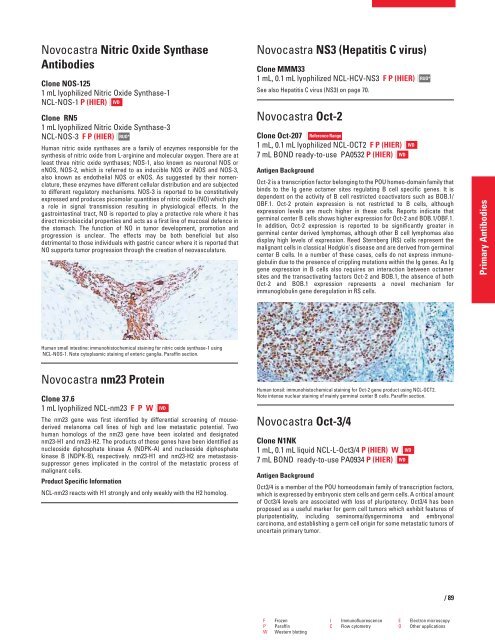QF0159 Marketing Release Record
QF0159 Marketing Release Record
QF0159 Marketing Release Record
Create successful ePaper yourself
Turn your PDF publications into a flip-book with our unique Google optimized e-Paper software.
Novocastra Nitric Oxide Synthase<br />
Antibodies<br />
Clone NOS-125<br />
1 mL lyophilized Nitric Oxide Synthase-1<br />
NCL-NOS-1 P (HIER) IVD<br />
Clone RN5<br />
1 mL lyophilized Nitric Oxide Synthase-3<br />
NCL-NOS-3 F P (HIER) RUO*<br />
Human nitric oxide synthases are a family of enzymes responsible for the<br />
synthesis of nitric oxide from L-arginine and molecular oxygen. There are at<br />
least three nitric oxide synthases; NOS-1, also known as neuronal NOS or<br />
nNOS, NOS-2, which is referred to as inducible NOS or iNOS and NOS-3,<br />
also known as endothelial NOS or eNOS. As suggested by their nomenclature,<br />
these enzymes have different cellular distribution and are subjected<br />
to different regulatory mechanisms. NOS-3 is reported to be constitutively<br />
expressed and produces picomolar quantities of nitric oxide (NO) which play<br />
a role in signal transmission resulting in physiological effects. In the<br />
gastrointestinal tract, NO is reported to play a protective role where it has<br />
direct microbiocidal properties and acts as a first line of mucosal defence in<br />
the stomach. The function of NO in tumor development, promotion and<br />
progression is unclear. The effects may be both beneficial but also<br />
detrimental to those individuals with gastric cancer where it is reported that<br />
NO supports tumor progression through the creation of neovasculature.<br />
Human small intestine: immunohistochemical staining for nitric oxide synthase-1 using<br />
NCL-NOS-1. Note cytoplasmic staining of enteric ganglia. Paraffin section.<br />
Novocastra nm23 Protein<br />
Clone 37.6<br />
1 mL lyophilized NCL-nm23 FPW<br />
The nm23 gene was first identified by differential screening of mousederived<br />
melanoma cell lines of high and low metastatic potential. Two<br />
human homologs of the nm23 gene have been isolated and designated<br />
nm23-H1 and nm23-H2. The products of these genes have been identified as<br />
nucleoside diphosphate kinase A (NDPK-A) and nucleoside diphosphate<br />
kinase B (NDPK-B), respectively. nm23-H1 and nm23-H2 are metastasissuppressor<br />
genes implicated in the control of the metastatic process of<br />
malignant cells.<br />
Product Specific Information<br />
NCL-nm23 reacts with H1 strongly and only weakly with the H2 homolog.<br />
IVD<br />
Novocastra NS3 (Hepatitis C virus)<br />
Clone MMM33<br />
1 mL, 0.1 mL lyophilized NCL-HCV-NS3 F P (HIER)<br />
See also Hepatitis C virus (NS3) on page 70.<br />
Novocastra Oct-2<br />
Clone Oct-207 Reference Range<br />
1 mL, 0.1 mL lyophilized NCL-OCT2 F P (HIER)<br />
7 mL BOND ready-to-use PA0532 P (HIER)<br />
Antigen Background<br />
Oct-2 is a transcription factor belonging to the POU homeo-domain family that<br />
binds to the Ig gene octamer sites regulating B cell specific genes. It is<br />
dependent on the activity of B cell restricted coactivators such as BOB.1/<br />
OBF.1. Oct-2 protein expression is not restricted to B cells, although<br />
expression levels are much higher in these cells. Reports indicate that<br />
germinal center B cells shows higher expression for Oct-2 and BOB.1/OBF.1.<br />
In addition, Oct-2 expression is reported to be significantly greater in<br />
germinal center derived lymphomas, although other B cell lymphomas also<br />
display high levels of expression. Reed Sternberg (RS) cells represent the<br />
malignant cells in classical Hodgkin's disease and are derived from germinal<br />
center B cells. In a number of these cases, cells do not express immunoglobulin<br />
due to the presence of crippling mutations within the Ig genes. As Ig<br />
gene expression in B cells also requires an interaction between octamer<br />
sites and the transactivating factors Oct-2 and BOB.1, the absence of both<br />
Oct-2 and BOB.1 expression represents a novel mechanism for<br />
immunoglobulin gene deregulation in RS cells.<br />
Human tonsil: immunohistochemical staining for Oct-2 gene product using NCL-OCT2.<br />
Note intense nuclear staining of mainly germinal center B cells. Paraffin section.<br />
Novocastra Oct-3/4<br />
Clone N1NK<br />
1 mL, 0.1 mL liquid NCL-L-Oct3/4 P (HIER) W<br />
7 mL BOND ready-to-use PA0934 P (HIER)<br />
Antigen Background<br />
Oct3/4 is a member of the POU homeodomain family of transcription factors,<br />
which is expressed by embryonic stem cells and germ cells. A critical amount<br />
of Oct3/4 levels are associated with loss of pluripotency. Oct3/4 has been<br />
proposed as a useful marker for germ cell tumors which exhibit features of<br />
pluripotentiality, including seminoma/dysgerminoma and embryonal<br />
carcinoma, and establishing a germ cell origin for some metastatic tumors of<br />
uncertain primary tumor.<br />
F Frozen I Immunofluorescence E Electron microscopy<br />
P Paraffin C Flow cytometry O Other applications<br />
W Western blotting<br />
IVD<br />
IVD<br />
IVD<br />
IVD<br />
RUO*<br />
/89<br />
Primary Antibodies
















